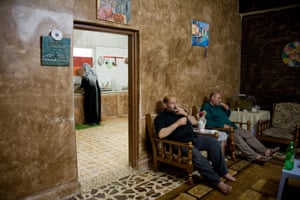‘Big tobacco wants our youth’s lungs’: rise of smoking in Jordan
When patients quit cigarettes at the King Hussein Cancer Center’s smoking clinic they are asked to be patient with their children. Often their offspring have been exposed to so much secondhand smoke that they have become addicted, too.
“For every four cigarettes their parent has smoked, the child has smoked one,” says Firas al-Hawari, a physician who directs the clinic. “We can control the parents with medication, but the kids are going through withdrawals because we don’t have them on medication.”
Figures published by the Guardian on Tuesday show that the Middle Eastern kingdom of Jordan has surpassed Indonesia to have the highest smoking rates in the world. Including e-cigarettes and other “smokeless” products, more than eight in 10 Jordanian men are nicotine users, according to a 2019 national survey carried out in collaboration with the World Health Organization.
Jordanian men who smoke daily consume an average of 23 cigarettes a day, the survey found. “In Jordan we consider someone who smokes a pack a day to be a light smoker,” Hawari says. “We have people who smoke three, five, seven packs a day. It is like it was in the 1950s or 1960s in other places.”
The proliferation of tobacco is obvious on a summer night in the country’s capital, Amman. Thick smoke wafts from water pipes and cigarettes in the courtyards of cafes and restaurants that have recently emerged from the country’s stringent coronavirus lockdown. Officials nonchalantly smoke in government offices, many of which are fitted with no-smoking signs. Even hospitals struggle to enforce bans in a country where more than a third of doctors are smokers, according to a 2013 survey.
Jordanians with conditions such as asthma can end up planning their lives around avoiding smoke. “They smoked all the time: at their desks, in the hallways, in the bathroom,” says Ruba Madhadha of her colleagues at the government agency where she worked. “I used to run away to my car to do emails, just to keep doing my job.”
For a few months she used steroid inhalers to manage her condition, but she finally had to leave the office in January. Smoking was officially banned in the building, she says. “But nobody does anything – no fines, no punishment.”
The impacts of so much smoking are already stark: tobacco use is linked to one in eight deaths in the country, compared with one in 10 deaths worldwide, and costs Jordan’s GDP an estimated three times the global average.
But Hawari say the true scale of the problem will be known in about 2030, when a bulk of the country’s disproportionately young population reaches 40 – the age at which tobacco-related illnesses, such as heart disease and cancer, start to manifest. “It’s going to cause an enormous surge in non-communicable diseases that we won’t be able to handle,” he says.
Surveys show tobacco use is still growing, on the back of a rise in women taking up the habit and the popularity of water pipes, which doctors say can be equivalent to consuming approximately three packs of cigarettes over a 45-minute session.
The emergence of e-cigarettes, marketed as a tool to help people stop smoking, have so far led to more people using nicotine overall than quitting cigarettes, according to the 2019 national/WHO statistics.
Smoking used to be endemic in wealthier countries such as the US, Australia and many in Europe. But decades of aggressive public health campaigns and restrictions on the ability of tobacco companies to advertise and lobby have succeeded in dramatically cutting their smoking rates.
Many of those corporate tactics have now migrated to countries in the Middle East and Africa, where regulations are more lax and poorly enforced, suggests Raouf Alebshehy, a monitoring coordinator in the tobacco control research group at the University of Bath. The majority of the world’s smokers now live in middle- and lower-income countries.
Analysts suspect smoking rates may be just as high in countries such as Iraq, Lebanon and Syria – Jordan is just advanced and stable enough to be able to measure its problem.
“What makes the Middle East region special in terms of its smoking rates?” Alebshehy says. “It isn’t lack of information. It’s a closed case that tobacco is harmful. One of the important factors we have found in this region is that the multinational companies started to invest and expand here. They started to shift work from developed markets to emerging markets here and in Africa where tobacco demand is still growing, and they bought up local manufacturers.”
Jordan has the most tobacco company interference in policymaking in the world after Japan, according to a 2019 analysis by a civil society group. “Big tobacco is preying on our countries, wanting to really own the lungs of our youth,” says Princess Dina Mired, the president of the Union for International Cancer Control and a member of the country’s royal family. “And they are doing so successfully.”
Many in government do not see a problem. Smoking is not even banned in the Jordanian parliament. When lawmakers tried to do so in 2004, a report in the Jordan Times says they had to reverse the decision as meetings started losing quorum because too many MPs were outside have a cigarette.
Those who push to implement the same anti-smoking laws that have been effective overseas say they are warned of the financial impact in a country where tobacco taxes make up 18% of annual revenues – and probably a larger share now with Covid-19 paralysing Jordan’s lucrative tourism industry.
“Members of parliament tell me: ‘This is an economic matter, you are affecting the Jordanian economy and threatening the jobs of people working in the industry’,” says Mervat Mheerat, the deputy manager for health in Greater Amman Municipality. “They correlate tobacco with the economy. And that’s the message they get from the tobacco industry.”
Source: Read Full Article


